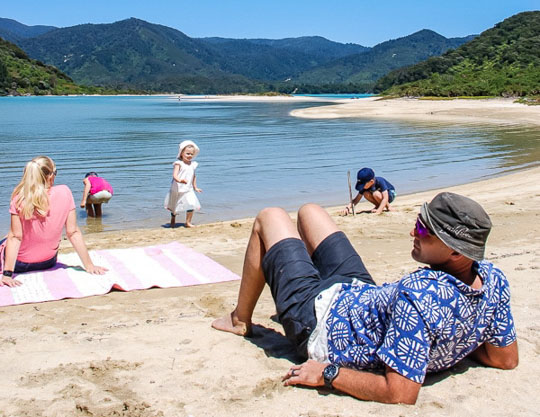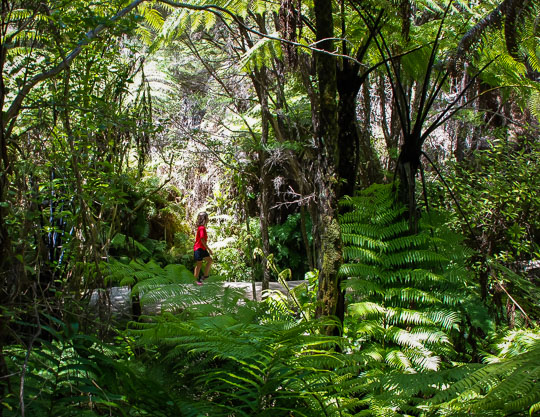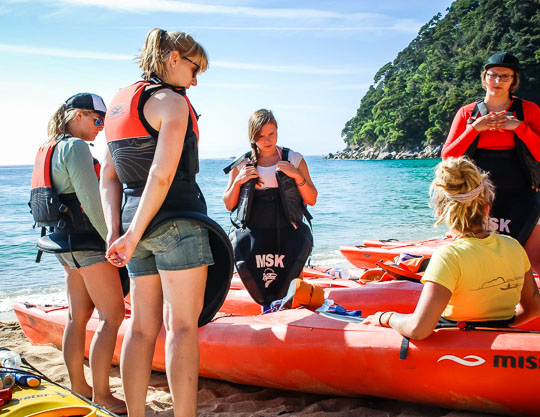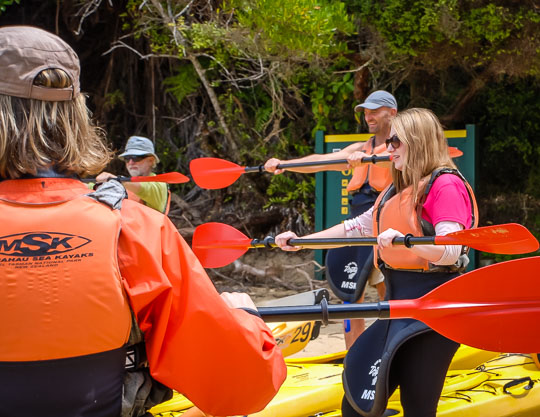Safety in the Abel Tasman
The Abel Tasman is the safest and most accessible of New Zealand’s national parks
The Abel Tasman National Park has a fantastic safety record, thanks largely to the care and attention paid to safety by the commercial operators.
The only hazards within the park are natural, with crime being low to non-existent. You don’t need the outdoor survival skills of Bear Grylls to enjoy a safe and comfortable outdoor experience in the Abel Tasman National Park.
The water taxis that whiz up and down the park all day are the unofficial safety wardens of the park and will keep an eye on kayakers and other park users. The Tasman District Council also has a Coast Guard monitoring the coastline, and the Department of Conservation have rangers stationed at various huts throughout the park. Indeed, the accessibility and ease of the Abel Tasman for its visitors is one of its main attractions.

Keeping Yourself Safe
The Sun
The region gets a lot of sunshine, and the New Zealand’s sunshine can burn you like yesterday’s toast if you give it half a chance. Even if you can spend several hours in the sun in your home country without incident, this will not be the case in New Zealand. If you apply sunscreen and wear a hat and sunglasses, you’ll do just fine. If you don’t, then you will probably end your day with people looking at your red skin with pitying eyes.
Drinking Water
Becoming dehydrated is another easy hazard to avoid, as is the unwelcome attention of mosquitos and sandflies, simply by taking plenty of drinking water, and some decent insect repellent.
Bees & Wasps
There can be large numbers of wasps and bees at certain times of the year so you will need to take your own medication if you are allergic to stings. The guides on walking and kayaking trips all carry first aid kits, and have anaphylaxis kits on them or have easy access to them.
Communication
Cell phone coverage in the park is patchy at best and the only public phones are at Torrent Bay and Totaranui. In the event of an emergency, seek out either a commercial operator (who will generally have a VHF radio) or a DOC ranger. New Zealand has incredible search and rescue system. This includes a network of helicopters that will come to your aid if things do go sideways on you.
Tell someone you’re going to the park
Even though the Abel Tasman is incredibly easy to navigate and is clearly signposted, you should let somebody know your intentions. This includes when you’re starting your trip, where you plan to be each night if you’re on a multi-day trip, and when you’ll be out of the Park.



Water Safety
Every sea kayak trip, even freedom rentals, starts with a safety briefing. Even if you won the kayaking gold medal in the 1984 Olympics, an experienced kayak guide will brief you for about 20 minutes on how to keep yourself safe during your trip. You will also be issued all of the safety gear you need, including a life jacket, flares, a hand pump and a split paddle.
Signing up for a guided trip is the safest and most comfortable introduction to sea kayaking. All guides either have formal sea kayak training or equivalent experience and will spend the trip making sure you, and everybody else on your trip, is safe and comfortable.
Every guided kayaking company in New Zealand must gain Adventure Activity certification before they are allowed to operate. This is a rigorous safety system, including an annual audit process that every operator takes seriously. There really isn’t any wiggle room for the operator or you as a client. If the operator feels like you’re in any danger you won’t even make it onto the water.
In the same way, all water transport operators must pass Maritime New Zealand’s MOSS (Maritime Operator Safety System) certification process. Your water taxi skipper will brief you on how to remain safe aboard their vessel and will issue you with a life jacket if necessary.
The salty sea-dogs who control the operations for the kayaking and water taxi companies make the final call on whether services go ahead in adverse conditions. These people are professionals and have all been operating in the Abel Tasman for more years than they will be willing to admit.
